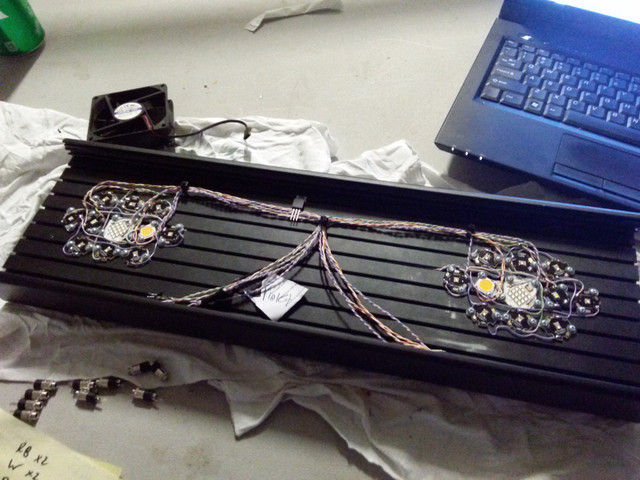lingwendil
Man who sold the world
Slightly excited so I'm reviving this to show some testing-
Citizen CLU028 97CRI 4000k Neutral White (11.4 watts at 38volts, 300mA)
Luxeon Lime
Luxeon K16 Royal Blue (easy to find all over FleaBay, AliExpress, and similar sites, these are the real deal, just surplus) (for Toshiba remote phosphor fixture) these can do 45 watts of dissipation, for 23,000+mw of radiance!
Lashed up really quick on a RapidLED Premium Heatsink, white/lime driven in series at 300mA, royal blue at 700mA.


These suckers are very, very powerful, and the colors are fantastic. It has a very subtle hint of that pink/magenta look that will be easy to counteract with the other colors I will be adding to the array. The overall look is pretty close to a 12,000k halide, and much less pink than the picture shows-

Pardon my potato quality picture, it ended up very dark for some reason, and the color isn't true at all...
The plan is so far to add 2x violet, 4x cool/regular blue, 1 or 2x cyan, and build two total clusters, and it will end up over a 40breeder or similar size setup for a "display" frag setup. Even as a standalone setup it looks phenomenally better than the basic cool white/royal blue combo, and would do very well as an array on its own for a warmer desired look. This also blows away the "dream chip" types of multichips in cost and efficiency, as well as having nicer color, even unsupplemented.
The best part? Those K16 arrays are only $5 each shipped, and the Citizen whites are less than $8, although you could do similar quality with less CRI if you went with a Bridgelux Vero for $3.75 each, and end up with a very economical base set to build on with your other colors.
Citizen CLU028 97CRI 4000k Neutral White (11.4 watts at 38volts, 300mA)
Luxeon Lime
Luxeon K16 Royal Blue (easy to find all over FleaBay, AliExpress, and similar sites, these are the real deal, just surplus) (for Toshiba remote phosphor fixture) these can do 45 watts of dissipation, for 23,000+mw of radiance!
Lashed up really quick on a RapidLED Premium Heatsink, white/lime driven in series at 300mA, royal blue at 700mA.


These suckers are very, very powerful, and the colors are fantastic. It has a very subtle hint of that pink/magenta look that will be easy to counteract with the other colors I will be adding to the array. The overall look is pretty close to a 12,000k halide, and much less pink than the picture shows-

Pardon my potato quality picture, it ended up very dark for some reason, and the color isn't true at all...
The plan is so far to add 2x violet, 4x cool/regular blue, 1 or 2x cyan, and build two total clusters, and it will end up over a 40breeder or similar size setup for a "display" frag setup. Even as a standalone setup it looks phenomenally better than the basic cool white/royal blue combo, and would do very well as an array on its own for a warmer desired look. This also blows away the "dream chip" types of multichips in cost and efficiency, as well as having nicer color, even unsupplemented.
The best part? Those K16 arrays are only $5 each shipped, and the Citizen whites are less than $8, although you could do similar quality with less CRI if you went with a Bridgelux Vero for $3.75 each, and end up with a very economical base set to build on with your other colors.
Last edited:


